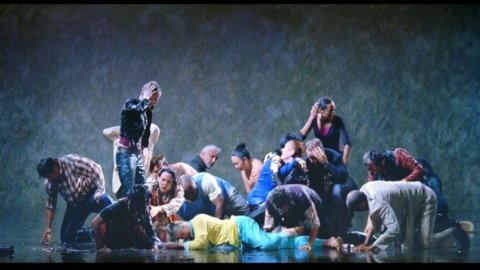It will be up to Bill Viola (New York, 1951), considered the greatest video artist in the world, to sign the second intervention of the cycle "The house of the gods", a project that sees international protagonists of contemporary art dialogue with the spaces of Palazzo Te of Mantua.
After the installation by Fabrizio Plessi created in the Sala dei Giganti, which inaugurated the cycle, the American artist will occupy from the 23 November 2013 to the 20 February 2014 the Napoleonic rooms with the work entitled The Raft, a video lasting about 10 minutes that tells, with a fixed shot and slowed down images, the fall and resistance of a group of 19 people in modern clothes while they are hit by a violent jet of water.
Bill Viola, famous for being one of the first to make use of video intended not only as a technological experimentation but as a contemplative and aesthetic one, has often and willingly taken the iconography of Italian Renaissance painting as a source of inspiration. Famous tables and altarpieces, such as the Visitation by Pontormo (The Greeting, 2002) or the Deposition by Masolino (emergency, 1995) have become veritable paintings in motion in his hands. Among these works it stands out for its size and drama The Raft, built in 2004.
The word raft, translated into Italian, variously means "raft", "lifeboat", terms that suggest a condition of danger, of emergency, which Viola interprets by taking up some scenes painted by Giulio Romano in the Sala dei Giganti, where the latter are dragged ashore by violent flows of water, in a desperate attempt to save themselves.
The catalog (bilingual Italian and English), published by Publi Paolini, in addition to the introduction edited by Marco Tonelli, councilor for culture of the Municipality of Mantua, will contain a critical text written for the occasion by Valentina Valentini (the most authoritative Italian expert on work by Bill Viola) and a description of the work made by the artist himself, accompanied by his annotations, sketches and preparatory drawings.
The initiative is conceived and promoted by the Department of Cultural Policies and Tourism Promotion of the Municipality of Mantua.
In this video/sound installation, a group of nineteen characters, men and women belonging to different ethnic groups and social backgrounds, are suddenly hit by strong jets of water from both sides of the frame, so violent that some characters fall land immediately, while others can barely stand. As suddenly as it had come, the water stops, leaving individuals astonished and incredulous, some relieved, some in agony.
The action was recorded live at high speed, but takes place in slow motion for approximately 10 minutes. The purpose of this technical trick is to highlight the subtle nuances of light and color in the explosive impact of the water as well as the individual expressions and gestures of the characters.
Bill Viola (New York, 1951), an internationally renowned multimedia artist, was one of the forerunners of video as a vital form of contemporary art. For forty years he has been creating architectural video installations, video films, sound environments, electronic music performances, video representations on flat screens, videos for television broadcasts, for musical concerts, for plays and sacred spaces. His one-channel videotapes have been widely released on DVD and his writings have been widely published and translated for international audiences.
Bill Viola's video creations masterfully use sophisticated multimedia technologies to delve into the exploration of the spiritual and perceptual aspects of human experience, focusing attention on the universal themes of mankind: birth, death, the discovery of awareness of the self are rooted in both Eastern and Western art, as well as in the spiritual traditions of Zen Buddhism, Islamic Sufism, and Christian mysticism.
His works are exhibited in museums and galleries around the world and are part of many famous collections. The most important exhibits of him include Bill Viola: Installations and Videotapes, at the MOMA in New York, 1987; Unseen Images, exhibition organized by the Kunsthalle Düsseldorf, 1992; Buried Secrets at the American pavilion of the 46th Venice Biennale, 1995; And Bill Viola: A 25-Year Survey, organized in 1997 by the Whitney Museum of American Art. In 2003 the J. Paul Getty Museum in Los Angeles organized Bill Viola: The Passions; in 2006 Bill Viola as Hatsu-Yume (first dream) attracted 340 visitors to the Mori Art Museum in Tokyo and in 2008 the Palazzo delle Esposizioni in Rome presented Bill Viola: Inner Visions. In 2010, two works from the "Tristan" series were presented in the Aula Magna of the University of Bologna, and the video installation was presented in the Tribuna del David of the Galleria dell'Accademia in Florence Emergence.
After graduating from Syracuse University in 1973, Viola studied and worked with composer David Tudor, experimenting with sonic music and sculpture. Her music projects include: video / film Deserts, created in 1994 to accompany the musical composition Deserts by Edgard Varèse; a suite of three new video performances for rock band Nine Inch Nails' “Fragility” world tour in 2000; creating a four-hour video for Peter Sellars' production Tristan and Isolde by Richard Wagner in 2005. From 1974 to 1976, he was technical director of production in Florence of the video art studio Art/Tapes/22, collaborating with European and American artists (G. Paolini, M. Merz, J. Kounellis, V. Acconci). With a long stay in Japan (1980-81, as part of the Japan / US creative arts fellowship) he deepened his study of advanced video technologies and his interests in oriental philosophies studying with Daien Tanaka, a Zen monk painter.
Viola has received many honors and awards, including a John D. and Catherine T. MacArthur Foundation Fellowship and the Eugene McDermott Award in the Arts, MIT. He has been made a member of the American Academy of Arts and Sciences, recognized as a Commander of the Order of Letters and Arts by the French Government and most recently awarded the 21st International Prize of Catalonia by the Government of Catalonia. He lives with his wife Kira Perov, his longtime collaborator, in Long Beach, California.
PURPLE BILL. The Raft
Mantua, Palazzo Te (Viale Te)
November 23, 2013 - February 20, 2014





